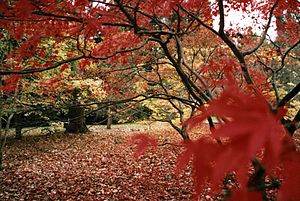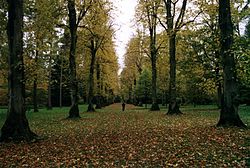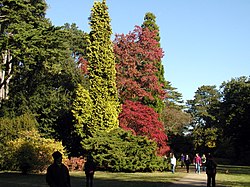Westonbirt Arboretum: Difference between revisions
Created page with "right|thumb|300px|The arboretum in autumn right|thumb|250px|A tree-lined avenue at Westonbirt Fil..." |
No edit summary |
||
| Line 3: | Line 3: | ||
[[File:autumn.scene.at.westonbirt.arp.jpg|right|thumb|250px|An autumn scene at the arboretum, late October]] | [[File:autumn.scene.at.westonbirt.arp.jpg|right|thumb|250px|An autumn scene at the arboretum, late October]] | ||
{{county|Gloucestershire}} | {{county|Gloucestershire}} | ||
'''Westonbirt Arboretum''', which now calls itself | '''Westonbirt Arboretum''', which now calls itself formally '''Westonbirt, The National Arboretum''' is an arboretum on the borders of [[Gloucestershire]] and [[Wiltshire]], about three miles south-west of the town of [[Tetbury]]. | ||
It is managed by [[Forestry Commission|Forestry England]], and is perhaps the most important and widely known arboretum in the United Kingdom.<ref>[https://www.forestry.gov.uk/westonbirt Westonbirt]: Forestry Commission</ref> | It is managed by [[Forestry Commission|Forestry England]], and is perhaps the most important and widely known arboretum in the United Kingdom.<ref>[https://www.forestry.gov.uk/westonbirt Westonbirt]: Forestry Commission</ref> | ||
Westonbirt Arboretum was planted in the heyday of Victorian plant hunting in the mid-19th century as part of the [[Westonbirt House]] estate, the arboretum forms part of a site which is listed Grade I on the Register of Historic Parks and Gardens of special historic interest.<ref>{{NHLE|1000457|Westonbirt}}</ref> | |||
*Location map: {{wmap|51.606|-2.218|zoom=14}} | *Location map: {{wmap|51.606|-2.218|zoom=14}} | ||
| Line 35: | Line 35: | ||
==Outside links== | ==Outside links== | ||
{{commons|Westonbirt Arboretum}} | {{commons|Westonbirt Arboretum}} | ||
*[https://www.forestryengland.uk/westonbirt-the-national-arboretum | *[https://www.forestryengland.uk/westonbirt-the-national-arboretum Westonbirt Arboretum: The Forestry Commission] | ||
*[http://www.fowa.org.uk/ Friends of Westonbirt Arboretum] | *[http://www.fowa.org.uk/ Friends of Westonbirt Arboretum] | ||
*[https://westonbirt.arboretumexplorer.org/ The Westonbirt map] – interactive map with ability to search for and highlight particular species | *[https://westonbirt.arboretumexplorer.org/ The Westonbirt map] – interactive map with ability to search for and highlight particular species | ||
Latest revision as of 08:21, 21 August 2019



Westonbirt Arboretum, which now calls itself formally Westonbirt, The National Arboretum is an arboretum on the borders of Gloucestershire and Wiltshire, about three miles south-west of the town of Tetbury.
It is managed by Forestry England, and is perhaps the most important and widely known arboretum in the United Kingdom.[1]
Westonbirt Arboretum was planted in the heyday of Victorian plant hunting in the mid-19th century as part of the Westonbirt House estate, the arboretum forms part of a site which is listed Grade I on the Register of Historic Parks and Gardens of special historic interest.[2]
- Location map: 51°36’22"N, 2°13’5"W
- Streetmap: ST848898
Westonbirt Arboretum backs onto the Highgrove Estate of Prince Charles, the Prince of Wales.
History
There is evidence of coppicing at the site from 1292.[3] The first use of the name "Weston Birt" is in 1309. This was taken from Weston, a settlement to the west of Bowldown Road, and Birt from then lords of the manor, the Bret family.[3]
The arboretum was established in 1829 by Robert Stayner Holford and was later extended by his son George Lindsay Holford. After the death of George in 1926, ownership of the arboretum passed to his nephew the fourth Earl of Morley, and eventually to the Forestry Commission in 1956 and Forestry England in 2019. The Holford family's mansion, Westonbirt House, became a girls' boarding school in 1927 when it was separated from the arboretum.
Today
Westonbirt Arboretum comprises some 18,000 trees and shrubs, over an area of approximately 600 acres. Its 17 miles of marked paths are popular with visitors, and provide access to a wide variety of rare plants. There are two main areas to explore. The Old Arboretum is a carefully designed landscape offering beautiful vistas, stately avenues, and a host of rare and exotic trees from across the globe dating back to the 1850s. Silk Wood is a very different experience: although it also contains many exotic plantings, at its heart is a traditional working woodland, dating back to the 13th century. Dogs are welcome in Silk Wood but not allowed in The Old Arboretum.
Throughout the arboretum, each specimen tree is labeled, either on the trunk or one of the low-hanging branches. Blue labels indicate Westonbirt's 'champion trees', the tallest or largest of their kind in Britain; in 2011 there were 79 of these.
The arboretum is managed by Forestry England, which also manages Bedgebury Pinetum in Kent. Westonbirt Arboretum is supported by the Friends of Westonbirt Arboretum charity.
Music and Festivals
From 2003 to 2005 the arboretum hosted Britain's first designer-led garden festival: Westonbirt Festival of the Garden.[4]
In 2011, Treefest was launched. Following several successful years of the Festival of the Tree event, Westonbirt Arboretum refreshed the popular August bank holiday event with camping, music and more activities celebrating trees and nature. [5]
Christmas and the spectacle of bare, sculpted trees in winter is celebrated at the Enchanted Christmas event. From the end of November and throughout December, an evening illuminated trail runs throughout the Old Arboretum, highlighting the beauty of Westonbirt's trees in winter.
Outside links
| ("Wikimedia Commons" has material about Westonbirt Arboretum) |
- Westonbirt Arboretum: The Forestry Commission
- Friends of Westonbirt Arboretum
- The Westonbirt map – interactive map with ability to search for and highlight particular species
- Images of Westonbirt Arboretum at monumentaltrees.com
References
- ↑ Westonbirt: Forestry Commission
- ↑ National Heritage List 1000457: Westonbirt
- ↑ 3.0 3.1 Westonbirt's timeline': Forestry Commission; states "1292 - earliest evidence for coppicing Silk Wood; 1309 - first recorded use of name Weston Birt – Weston derived from location of settlement west of Roman Bowldown Road, Birt from the Bret family, then lords of the manor"
- ↑ Westonbirt Festival of the Garden
- ↑ Treefest
